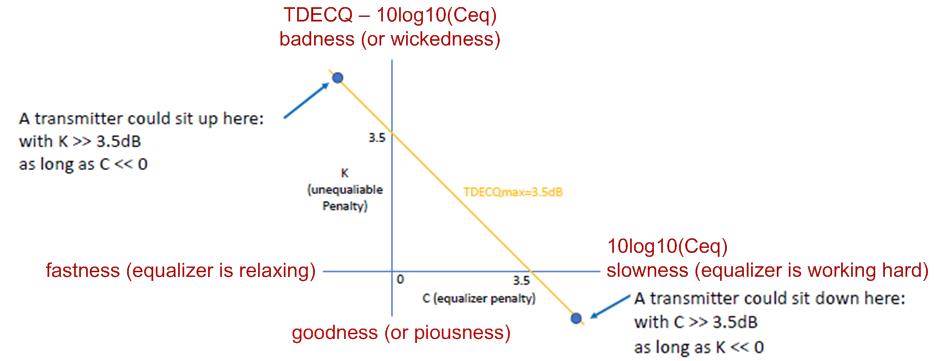Dear 802.3cu Task Force Members,
During the January meeting, the decision was made to drop TDECQ – 10log10(Ceq) from 802.3cu spec. Unfortunately, an effort is now being made to bring it back.
Gary deserves credit by for simplifying for us the elaborate and tangled arguments used to date in support of this spec.
http://www.ieee802.org/3/cu/public/March20/nicholl_3cu_03_031720.pdf
On p.3, Gary shows that it’s all based on plot of TDECQ – 10log10(Ceq) vs. 10log10(Ceq). This plot has been on almost every page of every supporting presentation; ~20 times during the 07/18 meeting, and ~20
times during the 03/05/20 Ad Hoc.
Below is the plot on Gary’s p.4, with labels in rust added to put all assumptions conveniently in one place.

Ceq
At this point, there is broad understanding of Ceq, including its mathematical relation to TX bandwidth and overshoot.
http://www.ieee802.org/3/cu/public/Jan20/cole_3cu_01b_0120.pdf#page=6
Those that argue against this relationship (http://www.ieee802.org/3/cu/public/cu_adhoc/cu_archive/dawe_3cu_adhoc_030520_v2.pdf#page=13
), are referred to basic Fourier analysis references (ex.
https://en.wikipedia.org/wiki/Fourier_series ), or courses (ex.
https://see.stanford.edu/Course/EE261 ).
Based on decades of optical link design experience we know that the slow and fast TX corners needs to be constrained to prevent interop problems (http://www.ieee802.org/3/cu/public/Jan20/cole_3cu_01b_0120.pdf
). We added the slow limit in 802.3bs (rise/fall time), but ran out of time to add the fast limit. We are doing this now in 802.3cu (overshoot/undershoot limit). Gary neatly shows this in light blue color on p.5 and p.6. However, he relies only on tap weights
for the fast corner. It is insufficient to just reach into a device and force design choices. What if a simple low-cost transmitter doesn’t have a FIR and DAC? This is an artificial and unnecessary constraint.
Correct specification methodology is to limit externally measurable behavior (referred to as black box). That’s why we need time domain limits. Claims in a few D2.0 comments that this is expensive and not
needed because DSP based TX is low-cost, run counter to all past experience.
TDECQ – 10log10(Ceq) (also referred to as K)
In the above plot, Gary points to a bad upper left point for K >> 3.5db, and bad lower right point for K << 0. However, since 07/18 there has been no real data presented showing the behavior in these “bad”
corners. Penalty quantifies the difference in device operation at two different operating conditions, as measured by BER, or as correlated to BER. None of the graphs, arrows, equations, extrapolations, labels, footnotes, claims, and conclusions, have real
penalty measurements on real devices in support.
There have been repeated requests for real BER based penalty measurements, and none has been forthcoming. Gary’s graph explains why; the upper left bad point is in the fast left half, and 100G TXs have been
slow up to now. Gary confirms this by noting that fast transmitters are atypical. The lower right corner is in the goodness or piousness lower half, and spectacular 100G TXs are yet to be found. So statements like badness, wickedness, unequalizable penalty
(even unequaliable penalty in Gary’s plots) are speculation because no devices exist to quantify these many K adjectives.
Data has been presented on 50G PAM4 transmitters showing that speculation about TDECQ – 10log10(Ceq) has poor correlation to real BER measurements. These have been dismissed as insufficient, or not representative,
or using flawed components. This is the new normal in IEEE: make an unsubstantiated assertion, get it adopted as a spec, and then demand that others disprove beyond a shadow of a doubt that it’s wrong.
The lack of 50G PAM4 optical data in the IEEE is the industry paying the price for not focusing resources on 50G PAM4 which will soon ship in millions in 50G and 200G transceivers. Instead, the major effort
has gone into 100G PAM4 which is years away from high volume. This won’t happen before 100G PAM4 SerDes are widely available to get rid of today’s gear-boxes which have historically only shipped in low volume to early adopters.
Those that want to bring back TDECQ – 10log10(Ceq), should not just repeat assertions, theories, and circular analysis. They should bring BER based penalty measurements made on real devices.
https://www.youtube.com/watch?v=VnCajZth-24
Thank you
Chris
P.S. Gary also deserves credit for maintaining full impartiality while wearing his Editor’s hat, and separately putting on a contributor hat to argue in favor of his proposals.
From: Mark Nowell (mnowell) <00000b59be7040a9-dmarc-request@xxxxxxxx>
Sent: Thursday, March 05, 2020 4:13 AM
To: STDS-802-3-100G-OPTX@xxxxxxxxxxxxxxxxx
Subject: [802.3_100G-OPTX] Update Re: Proposed Agenda for 802.3cu ad hoc - Thurs 3/5
Dear Colleagues,
Today’s agenda has been updated with an additional presentation. See below.
Thanks, Mark
From: Mark Nowell <mnowell@xxxxxxxxx>
Date: Wednesday, March 4, 2020 at 4:06 PM
To: 100G OPTX <STDS-802-3-100G-OPTX@xxxxxxxxxxxxxxxxx>
Subject: Proposed Agenda for 802.3cu ad hoc - Thurs 3/5
Dear Colleagues,
The proposed agenda for the IEEE P802.3cu Task Force ad hoc on Thurs March 5th
is as follows:
- Approve agenda
- Approve previous ad hoc minutes
- Patent reminder
- Copyright and Participant reminder
- P802.3cu Task Force Ad hoc:
- “Task Force Update” – Mark Nowell (5 mins)
- “Chief Editor report” – Gary Nicholl (15 mins)
- “Trying to understand TDECQ” – Gary Nicholl (15 mins)
- “TDECQ, slowness, badness and overshoot” – Piers Dawe (25 mins)
-
“Impact of Tx Overshoot on Link Performance and TDECQ” – Roberto Rodes (20 mins)
|
|
Call information is posted at:
http://www.ieee802.org/3/cu/public/cu_adhoc/
Slides
will be posted in Ad Hoc area
http://www.ieee802.org/3/cu/public/cu_adhoc/cu_archive/index.html
Regards, Mark
To unsubscribe from the STDS-802-3-100G-OPTX list, click the following link:
https://listserv.ieee.org/cgi-bin/wa?SUBED1=STDS-802-3-100G-OPTX&A=1
To unsubscribe from the STDS-802-3-100G-OPTX list, click the following link: https://listserv.ieee.org/cgi-bin/wa?SUBED1=STDS-802-3-100G-OPTX&A=1